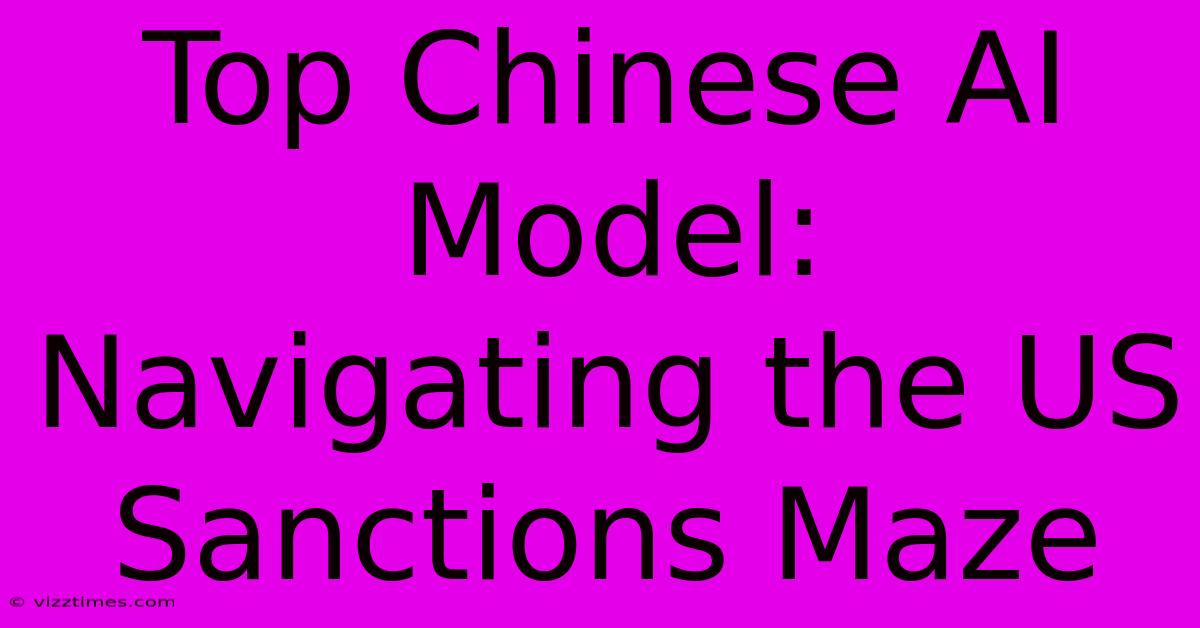Top Chinese AI Model: Navigating The US Sanctions Maze

Table of Contents
Top Chinese AI Models: Navigating the US Sanctions Maze
Hey everyone! So, you're interested in Chinese AI, huh? That's a hot topic right now, especially with all the US sanctions swirling around. It's a complicated mess, but I'm gonna try to break it down for you in a way that’s hopefully understandable. Think of me as your friendly neighborhood AI explainer, not some stuffy professor.
Understanding the Sanctions Landscape: It's a Minefield!
Let's be real, the US government's relationship with Chinese AI development is… tense, to say the least. They're worried about national security, intellectual property theft, you name it. This has led to a bunch of sanctions targeting specific companies and technologies. I mean, seriously, it's like a never-ending game of whack-a-mole.
One of the biggest headaches for Chinese AI companies is access to advanced chips. These things are crucial for training powerful AI models, and a lot of the top-tier chips are made by US companies or use US technology. The sanctions make it incredibly difficult for Chinese firms to get their hands on them. This has a huge ripple effect throughout their entire supply chain. I remember reading a news article last year about a startup that basically had to completely redesign their system because they couldn't get the chips they needed. It was insane!
The Impact on Top Chinese AI Models
This chip shortage directly impacts the development of cutting-edge AI models in China. We're talking about large language models (LLMs) – the kind that power things like ChatGPT, but with a Chinese twist. These models require massive amounts of computing power for training, and without the right chips, progress slows to a crawl. They might be able to create models, but they might not be as powerful or as sophisticated as their American counterparts. It's like trying to bake a cake without an oven – you can do it, but it's gonna be a real struggle, and the result probably won't be very good!
Furthermore, sanctions often target specific algorithms or software libraries used in AI development. This further limits the capabilities of Chinese researchers and developers. It's like building a house with only half the tools – you might manage, but it will be inefficient and more prone to errors. This makes it extremely hard for them to compete on a global scale. I mean, these researchers are super smart, but they are working with one hand tied behind their backs.
Navigating the Maze: Strategies for Chinese AI Companies
So, how are Chinese companies trying to cope with all this? It's a constant game of adaptation. I've been reading a lot about this. Here are some of the strategies I've seen mentioned:
-
Increased Domestic Chip Production: China's been pouring resources into developing its own advanced chip manufacturing capabilities. Think of it as creating their own supply chain, rather than relying on outside companies. It's a huge undertaking, and it's not going to happen overnight, but it's a key part of their long-term strategy. It's like building a whole new road when the old one is blocked.
-
Alternative Architectures: Some companies are experimenting with different chip architectures that are less reliant on US technology. It's like finding a workaround – using different tools to achieve the same goal. This is a smart move, and if it pans out, it could significantly reduce their dependence on US imports.
-
Open-Source Software: Relying more on open-source software and tools can help reduce dependence on US-sanctioned technologies. Think of it as relying on community-supported tools rather than proprietary software. This is often less reliable but potentially more adaptable.
-
Focus on Specific Niches: Rather than trying to compete head-to-head with US companies across the board, some Chinese AI companies are focusing on specific niche areas where sanctions have less of an impact. It's a matter of focusing on strengths rather than weaknesses.
The Future of Chinese AI: Uncertain, but Definitely Interesting
The future of Chinese AI development is still very much up in the air. The sanctions create significant hurdles, but Chinese companies are demonstrating remarkable resilience and ingenuity. They're finding creative ways to overcome these obstacles. Will they succeed in becoming global leaders in AI? That's a question only time will answer. But one thing's for sure: this is a story that deserves to be watched closely. It's a fascinating clash of technological innovation and geopolitical strategy.
I've learned a lot following the news and various technical publications. It's a dynamic situation, so staying informed is crucial. And who knows, maybe in a few years, we’ll be talking about the leading Chinese AI model that changed the world! Keep your eyes peeled! There's a lot more to unpack here.
I hope this gave you a better understanding of the situation. Let me know if you have any questions or want to dive deeper into a specific aspect. It's a really complex topic, but I think it’s super interesting. And it’s definitely not something to ignore!

Also read the following articles
| Article Title | Date |
|---|---|
| Unexpected Twist Sinners Victory Over Shelton At The Australian Open 2025 | Jan 25, 2025 |
| Australian Open Heartbreak Players Post Match Fury Goes Viral | Jan 25, 2025 |
| Nhl Trade Frenzy Hurricanes Acquire Rantanen Hall From Avalanche | Jan 25, 2025 |
| Dress Code Disaster Why Your Ink And Outfit Could Cost You Your Job | Jan 25, 2025 |
| 132 129 Edge Sixers End Losing Streak Against Cleveland | Jan 25, 2025 |